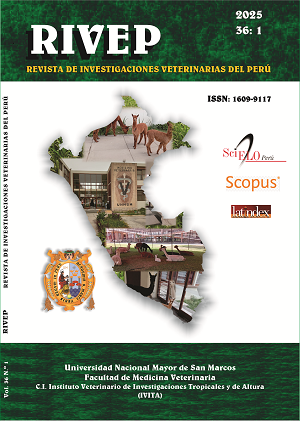Elbow dysplasia in canines from Medellín, Colombia: retrospective study
DOI:
https://doi.org/10.15381/rivep.v36i1.25977Keywords:
dogs, radiography, arthrosis, orthopaedics, growth, joint diseaseAbstract
The study aimed to determine the frequency of elbow dysplasia (ED) in canines by evaluating radiographs taken in veterinary clinics in the city of Medellín and its Metropolitan area between 2018 and 2020. Frequency tables and simple logistic regression were used with association between variables with the calculation of ED proportions according to sex, age and breed. A total of 292 radiographic studies were analysed. A greater proportion of cases was found in males (59%) than in females (41%), with 58.6% being older than 5 years. The Golden Retriever, Labrador Retriever, English Bulldog, Pug, Pitbull, Rottweiler and Mountain Bernese breeds had the highest presentation of ED in the studied population and showed a significant association between these breeds and the development of ED. A greater proportion of affected males was found compared to females. The present study shows a high frequency of ED in some breeds, with articular incongruity (AI) being the predominant primary lesion and osteoarthrosis (OA) being the most frequently associated secondary lesion.
Downloads
Downloads
Published
Issue
Section
License
Copyright (c) 2025 Camilo Forero-Parra, Carlos Riaño-Benavides, Diego Echeverry-Bonilla

This work is licensed under a Creative Commons Attribution 4.0 International License.
AUTHORS RETAIN THEIR RIGHTS:
a. Authors retain their trade mark rights and patent, and also on any process or procedure described in the article.
b. Authors retain their right to share, copy, distribute, perform and publicly communicate their article (eg, to place their article in an institutional repository or publish it in a book), with an acknowledgment of its initial publication in the Revista de Investigaciones Veterinarias del Perú (RIVEP).
c. Authors retain theirs right to make a subsequent publication of their work, to use the article or any part thereof (eg a compilation of his papers, lecture notes, thesis, or a book), always indicating the source of publication (the originator of the work, journal, volume, number and date).



